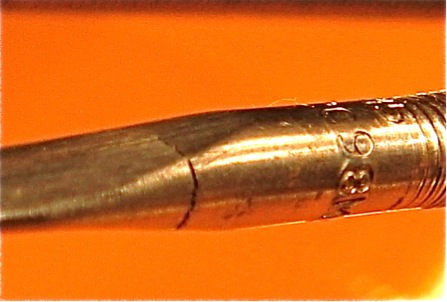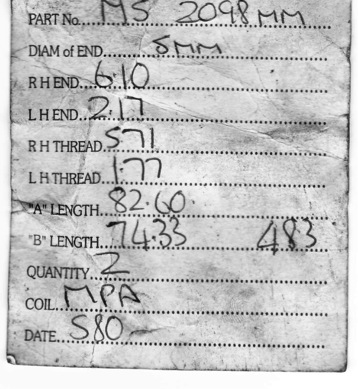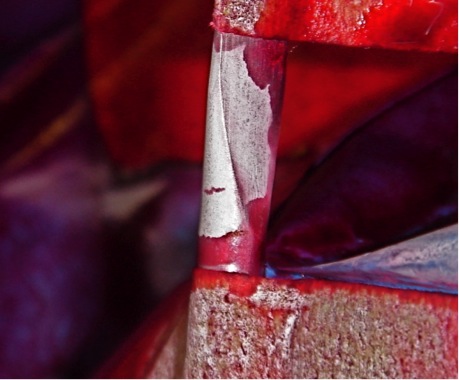The manufacture of streamlined wires is a very specialized, labor intensive process and is not exactly a main stream product in the 21st century. We are lucky that there is still one company able to produce these wires: Bruntons Aero products of Scotland. (See: http://www.streamlinewires.com and http://ssa.nls.uk/film.cfm?fid=0438 )
Such a technically demanding product manufactured by hand in extremely low volume is going to be subject to variations. The rest of this document describes some failures that have been observed in certain Brunton wires. Specifically these are metric, 5mm streamlined wires made from BS S80 standard stainless steel, a material that was in use prior to 2005.
So far, failures of the type described below have not been seen in the later SS 316 material, nor in any wires made by the McWhite company in the USA.
What follows is not intended to be a criticism of any company, product, or technology, but is provided here entirely in the interests of safety. Please inspect your wires very carefully, and if they fall within the parameters of those in which failures have been observed, PLEASE perform a dye penetrant test. This is easy to do and costs much less than even a modest pine casket. ( http://www.aircraftspruce.com/catalog/topages/metlchek.php?clickkey=33099 )
Copies of the metallurgy, other technical reports, and correspondence are available on request.
Many thanks to the author of this report for sharing his knowledge and insight, as well as for the significant expenditure it required.
SB
John Hickman has kindly provided some more information on how to identify Bruntons vs McWhite wires:
"The Brunton flying wires have rolled threads. The MacWhyte wires have cut threads. The best way to determine which wire you have is to measure the shank area between the streamline section and the threaded section. The Brunton wire will have a slightly less shank diameter (.3mm) than the threaded section diameter. The MacWhyte wire shank and threaded diameters are virtually the same."

Bruntons McWhyte
Cracked 5mm dia Landing and Brace Wires
This report is applicable to aircraft using 5 mm stainless steel streamline tie rods (flying, landing and brace wires on biplanes) that were made of alloy BS S80 by Bruntons prior to 2005.
There have been several failures of these wires, and many have cracked but not failed in flight (discovered during routine inspections). The manufacturer has, in the 10 failed wires that I am aware of, suggested that these cracks may be caused by improper installation and/or poor maintenance. In their defense, certain types of bad maintenance procedures and abuse can lead to cracks and failures. However, it is extremely unusual that EVERY one of these cracks happened in EXACTLY the same place on the wires: in the middle of the transition from round cross-section to streamline cross-section at the end of the right-hand threaded portion of the rod (see Figure 1). Some extensive research and analysis has taken place in Europe and Canada to find out why these wires cracked.

Figure 1. large crack in 5mm diameter streamlines tie rod made of BS S80
In 2011 Bruntons was given a detailed (and expensive) forensic report of wires that failed in 2008 and 2009. Bruntons disagreed with the authors' explanation of the failures, but several experts in the metallurgy business are of the opinion that Bruntons use of the alloy BS S80 is one of the reasons the wires cracked. BS S80 is the British equivalent of 431 in the United States and Bruntons used this alloy until 2005 for their metric wires. It is interesting to note that in 2005 Bruntons started making their metric wires with SS 316 - an alloy that is much more tolerant of the cold-forming operations involved in making these wires. They say that BS S80 was becoming difficult to source. But they continue to provide the hardware (clevis, forks, pins, etc.) made from BS S80.
In North America the MacWhyte Company in Kenosha Wisconsin provided the industry with Imperial dimensioned wires made of SS 316. They stopped making streamline tie rods in the 1990's, and Bruntons became the only available supplier of these wires. According to the Steen Aero website (Bruntons' North American distributor), the imperial wires they sell have always been made of SS 316. We are not aware of this type of failure on ANY diameter wire made of SS 316.
The theory necessary to explain why the wires are failing is beyond the scope of this report. Most of us just want to go flying, and do it without things breaking during flight. I have five cracked 5mm wires on my plane and a sixth has staining in the same place. So I am replacing EVERY wire on the airplane. It is expensive and Bruntons is not offering any assistance.
A way of identifying which material your wires are made of is to examine the finish.
If it appears bright and shinny it is likely 316. The S80 has a more "satin" and unpolished look. You can also look at the tag that came with the wire. Bruntons writes the SS alloy type on the bottom of the tag on the "DATE" line (see Figure 2). If you want to be sure, you can cut about ¼ inch off the end of one of your wires and send it to a lab for analysis.

Figure 2. Tag affixed to Bruntons wire. Date line shows the type of SS alloy.
If you do have S80 5mm wires, examine the transition section just after the right hand threads under VERY good light (see Figure 3.). These cracks are difficult to see in the hangar - outside in bright sunlight is best.

Figure 3. This crack was very hard to see - even in bright sunlight. Wire has been masked off,and dye penetrant used to verify the crack.
We have not seen or heard of any cracks at the left-hand thread part of the wires. And the only diameter wire that seems to crack this way is the 5mm wire. On my plane all the cracks have been on the forward facing surface - that is to say: the front of the wire if you are standing in front of the plane looking at a wire.
There is another problem with Bruntons wire assemblies. The wires are threaded onto a clevis that is also made of S80. When the wires leave the factory the threads are coated with a molybdenum disulphide grease so that when they are screwed into the clevis the parts don't bind. If that grease gets wiped off, or if the thread profile is not perfect, the possibility exists that the 2 parts will effectively "weld" themselves together. The wire will be destroyed if turned in either direction.
Most of us think that stainless steel is an "install and forget" type of product. This is simply not true. In some respects it is better than the carbon steel it has replaced, but corrosion of carbon steel is much easier to detect and correct. Stainless steel can corrode in ways that are not easily detectable - which can eventually cause a wire failure. Existing literature advises us to keep the wires clean and protected with wax or oil. This can't hurt, but it may not be enough to stop the stress corrosion cracks that can develop from microscopic breaks in the surface protective layer. Do not use cleaners that have any chlorine or chloride compounds. Once a chlorine atom gets past the surface chromium oxide layer the corrosion starts and cannot be detected easily. The area where the wires are cracking is the place of maximum stress concentration from the cold-forming operation during manufacture.
Constant vigilance is the only way to detect these cracks before they become a threat to safety. I have no idea what loading is required to break the wire after a crack has become visible, and we cannot predict the timeline from the time of crack detection until the time of wire failure.
The wires on my aircraft were made in 2003 or early 2004 and had 400 hours (mostly aerobatic) total time when the cracks appeared in 2012. As soon as I saw the cracks I stopped flying until new 316 wires were on the plane.
In order to avoid this type of failure, examine every 5 mm wire made of BS S80 very closely before every flight. Or get new 316 wires.
From Bruntons.......

